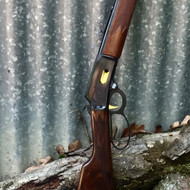Pistol Caliber Lever Action Rifle Ballistics: .357, .38, .44, .45
Posted by Adam Devine on Apr 26th 2022
Welcome to Part III of our lever action ballistics series.
Marlin’s re-introduction of the model 1894 chambered in the .44 and .357 magnums, back in the President Johnson and Nixon era, undoubtedly bolstered the popularity of the lever action rifle, which might have appeared a little stodgy by then. Unlike those presidents, both cartridges were highly regarded, even deified, in revolvers, and their fame and effectiveness grew even more as they picked up speed–literally–in rifles. This had no apparent halo effect on the oval office denizens.
Unlike their Special siblings, the Magnum bros have powder to burn in longer barrels, gaining an extra 200-400fps, and drastically increasing their range and lethality. Intrepid hunters went after large, dangerous game, even with the diminutive .357. Some of them came back. And wrote about it. Legends were born.
Today every serious lever gun maker offers rifle accessories in revolver chamberings. You can find the .357 and .44 in Marlin rifles, Henry rifles, Rossi rifles, Winchesters, and Chiappas, just to name the most prominent. Henry currently offers the zippy .327 Federal Mag by popular demand, and Rossi/Puma M92 variants can be found in .454 Casull and .480 Ruger, if you’re into the whole bear buster thing.
With the exception of the .480, these magnum cartridges all have smaller, softer siblings that predate them; the .38 and .44 Specials, the .32 H&R mag, and the .45 Colt. This second string lineup is great for plinking, and is easier on the shoulder and pocketbook.
Another common trait in all these pistol caliber rifles is their large capacity– as many as 8 or 10 to a magazine tube–resulting in a handgun-like rate of fire with near-rifle lethality. This is a perfect combination for self defense, given the right loadings, and the smaller mags come in plenty of appropriate defense loadings. Lighter bullets are relatively home-safe, while heavier bullets offer good penetration through glass, sheet metal, and other tactical barriers.
The pistol caliber rifles are still great for close range hunting, and in short carbine configurations, as pack rifles, patrol car carries, and ranch rigs. Their practical, even tactical, usefulness cannot be overstated. Tactical lever gun? Heresy? Not at all, in the right context. I’ve had a number of LEO customers over the years who swear by their .44 carbines. They out-power and out-penetrate both the AR-15 and AK-47, without the overpowering political rancor.
Appropriate use follows a fairly predictable graph, starting at small and medium game for the .327 up to deer for the .357, then through the range of tougher skinned large game with the .44 mag, ending at the big bears for the Casull and Ruger rounds, both of which easily exceed a ton of muzzle energy in a carbine barrel.
Speaking of barrels, if you’re the bob job type, then the pistol caliber carbines are really where it’s at. While the magnum revolver rounds have more than enough powder for a 6” wheel gun, they develop peak velocity in less than 16” of barrel, so chopping sacrifices no performance, only capacity. Plus, no need to seek out specialty subsonic ammo for your suppressed pistol caliber carbine. Just buy the “Special” version of your cartridge, which is cheaper anyway.
As I mentioned in Part II, accuracy in lever guns is largely dependent on the rifle, and this applies to the pistol calibers as well. Pistol rounds are generally viewed as less accurate than rifle bullets, and while that will generally be true at extended ranges, one of the most accurate rifles that I ever built was a match grade 1894 in .357 mag. It could touch three rounds at 100yds. A properly tuned factory rifle should be capable of an inch or better at 50yds.
If you’ve gotten the impression that I really like the revolver caliber carbines, you’d be correct. While the rifle caliber platforms are more capable than people give them credit for, the pistol carbines more fully capture the original spirit of the lever gun. They are small, light, nimble, and wonderful to carry and shoot from the shoulder. Compared to rifles, they are cheap to shoot, and easy to hand load, which is good, because their practical usefulness is second only to their plinking fun factor.
Thanks for joining us, and happy shooting! You’ll find additional reading in the link below.
The .357 Mag - The Bruce Lee of Survival Cartridge
Frequently Asked Questions
What caliber is a 38 special?
A 38 special is 357 inches (36 caliber/9.07 mm).
Which is more powerful 9mm or 38 special?
38 Special produces 147-grain bullets at 900 feet per second out of a 4-inch barrel, while standard pressure 9mm can produce 124-grain bullets at 1,150 feet per second. This makes the 9 mm more powerful.
When was colt 45 released?
The Colt 45 was released and adopted by the U.S. Army in 1873.

